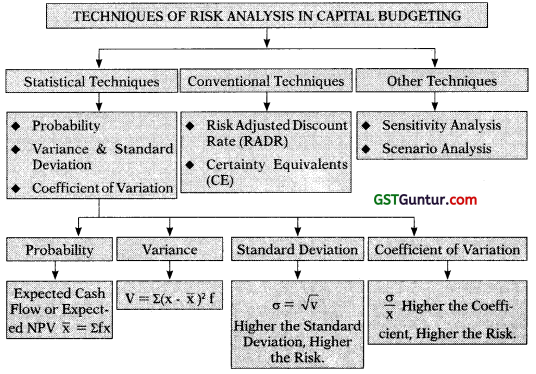Risk Analysis in Capital Budgeting – CA Inter FM Notes is designed strictly as per the latest syllabus and exam pattern.
Risk Analysis in Capital Budgeting – CA Inter FM Notes
1. Techniques of Risk Analysis in Capital Budgeting:

![]()
2. Probability:
Situation 1: Cash Flow is given with its probability:
Step 1 : Calculate Expected Cash Flow \((\overline{\mathrm{X}})\) with the help of probability
Step 2 : Calculate Expected NPV on the basis of expected cash flow
Step 3 : Take decision on the basis of Expected NPV
Situation 2 : NPV is given with its probability:
Step 1 : Calculate Expected NPV \((\overline{\mathrm{X}})\) with the help of probability
Step 2 : Take decision on the basis of Expected NPV
Mean \((\overline{\mathrm{X}})\) = Σfx
3. Variance (V) or (σ2):
Variance (V) or (σ2) = Σ(X – \(\overline{\mathrm{X}}\))2f
Higher the Variance higher the Risk.
4. Standard Deviation (σ) :
Standard Deviation (σ) = \(\sqrt{V}\)
Higher the Standard Deviation higher the Risk.
5. Coefficient of Variation
Higher the Coefficient of Variation higher the Risk.
6. Risk Adjusted Discount Rate (RADR):
- The use of risk adjusted discount rate (RADR) is based on the concept that investors demands higher returns from the risky projects.
- In this technique management use discount rate as per the risk associated with the project.
7. Certainty Equivalent (CE):
Certainly Equivalent Coefficient (∝) \(=\frac{\text { Certain Cash Flow }}{\text { Risky or Expected Cash Flow }}\)
Step 1 : Calculate Certain Cash:
Certain Cash = Expected Cash Flow × C.E. Coefficient
Step 2 : Calculate NPY on the basis of certain cash flow and risk free discount rate.
![]()
8. Sensitivity Analysis:
- Sensitivity analysis is used to study the impact of changes in the variables on the outcome of the project.
- The project outcome is studied after taking into change in only one variable.
9. Scenario Analysis:
- This analysis brings in the probabilities of changes in key variables and also allows us to change more than one variable at a time.
- Scenario analysis examine the risk of investment, to analyse the impact of alternative combinations of variables, on the project’s NPV (or IRR).